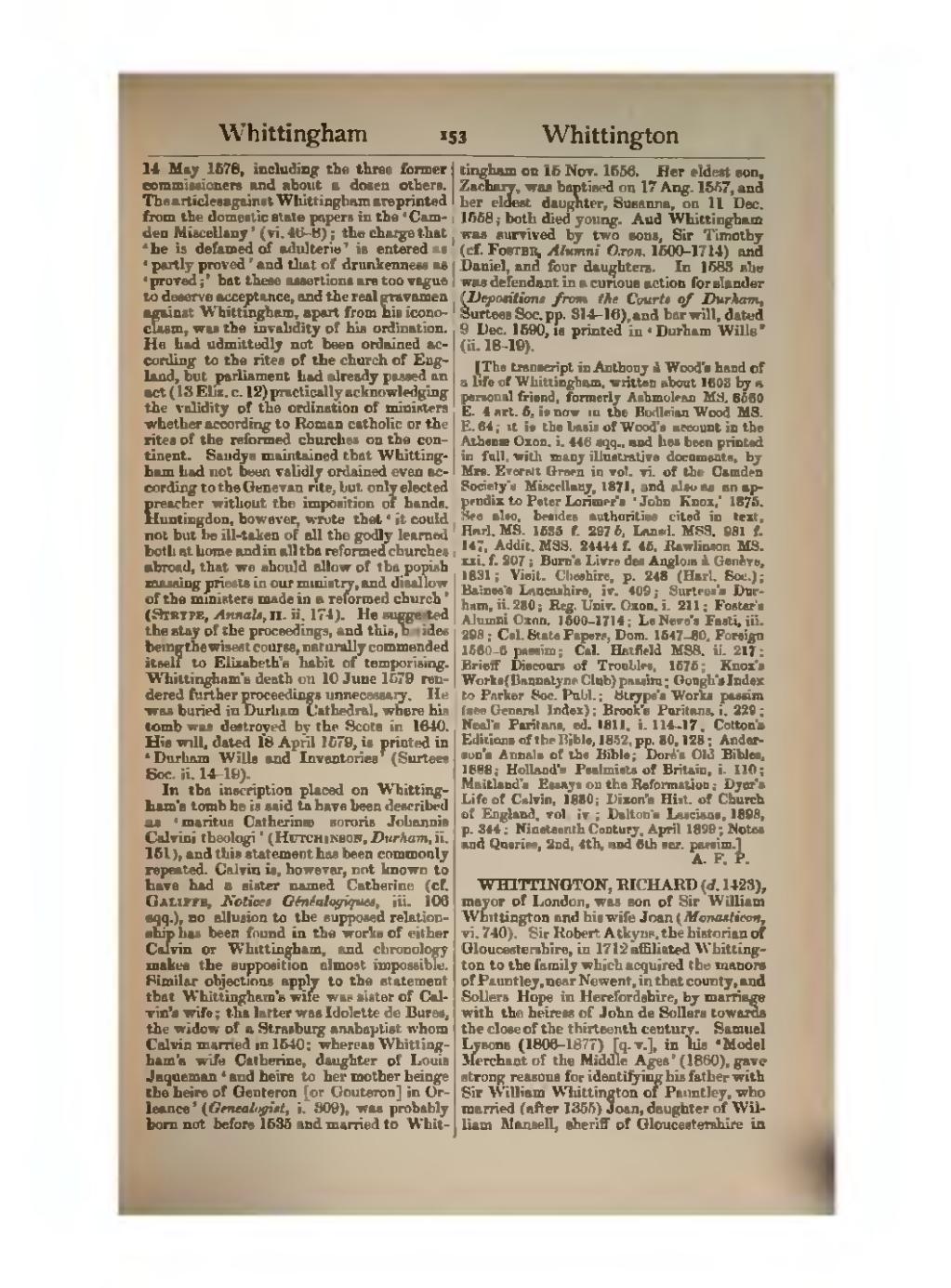14 May 1578, including the three former commissioners and about a dozen others. The articles against Whittingham are printed from the domestic state papers in the ‘Camden Miscellany’ (vi. 46–8); the charge that ‘he is defamed of adulterie’ is entered as ‘partly proved’ and that of drunkenness as ‘proved;’ but these assertions are too vague to deserve acceptance, and the real gravamen against Whittingham, apart from his iconoclasm, was the invalidity of his ordination. He had admittedly not been ordained according to the rites of the church of England, but parliament had already passed an act (13 Eliz. c. 12) practically acknowledging the validity of the ordination of ministers whether according to Roman catholic or the rites of the reformed churches on the continent. Sandys maintained that Whittingham had not been validly ordained even according to the Genevan rite, but only elected preacher without the imposition of hands. Huntingdon, however, wrote that ‘it could not but be ill-taken of all the godly learned both at home and in all the reformed churches abroad, that we should allow of the popish massing priests in our ministry, and disallow of the ministers made in a reformed church’ (Strype, Annals, ii. ii. 174). He suggested the stay of the proceedings, and this, besides being the wisest course, naturally commended itself to Elizabeth's habit of temporising. Whittingham's death on 10 June 1579 rendered further proceedings unnecessary. He was buried in Durham Cathedral, where his tomb was destroyed by the Scots in 1640. His will, dated 18 April 1579, is printed in ‘Durham Wills and Inventories’ (Surtees Soc. ii. 14–19).
In the inscription placed on Whittingham's tomb he is said to have been described as ‘maritus Catherinæ sororis Johannis Calvini theologi’ (Hutchinson, Durham, ii. 151), and this statement has been commonly repeated. Calvin is, however, not known to have had a sister named Catherine (cf. Galiffe, Notices Généalogiques, iii. 106 sqq.), no allusion to the supposed relationship has been found in the works of either Calvin or Whittingham, and chronology makes the supposition almost impossible. Similar objections apply to the statement that Whittingham's wife was sister of Calvin's wife; the latter was Idolette de Bures, the widow of a Strasburg anabaptist whom Calvin married in 1540; whereas Whittingham's wife Catherine, daughter of Louis Jaqueman ‘and heire to her mother beinge the heire of Genteron [or Gouteron] in Orleance’ (Genealogist, i. 309), was probably born not before 1535 and married to Whittingham on 15 Nov. 1556. Her eldest son, Zachary, was baptised on 17 Aug. 1557, and her eldest daughter, Susanna, on 11 Dec. 1558; both died young. And Whittingham was survived by two sons, Sir Timothy (cf. Foster, Alumni Oxon. 1500–1714) and Daniel, and four daughters. In 1583 she was defendant in a curious action for slander (Depositions from the Courts of Durham, Surtees Soc. pp. 314–16), and her will, dated 9 Dec. 1590, is printed in ‘Durham Wills’ (ii. 18–19).
[The transcript in Anthony à Wood's hand of a life of Whittingham, written about 1603 by a personal friend, formerly Ashmolean MS. 8560 E. 4 art. 5, is now in the Bodleian Wood MS. E. 64; it is the basis of Wood's account in the Athenæ Oxon. i. 446 sqq., and has been printed in full, with many illustrative documents, by Mrs. Everett Green in vol. vi. of the Camden Society's Miscellany, 1871, and also as an appendix to Peter Lorimer's ‘John Knox,’ 1875. See also, besides authorities cited in text, Harl. MS. 1535 f. 297 b, Lansd. MSS. 981 f. 147, Addit. MSS. 24444 f. 45, Rawlinson MS. xxi. f. 207; Burn's Livre des Anglois à Genève, 1831; Visit. Cheshire, p. 248 (Harl. Soc.); Baines's Lancashire, iv. 409; Surtees's Durham, ii. 230; Reg. Univ. Oxon. i. 211; Foster's Alumni Oxon. 1500–1714; Le Neve's Fasti, iii. 299; Cal. State Papers, Dom. 1547–80, Foreign 1560–6 passim; Cal. Hatfield MSS. ii. 217; Brieff Discours of Troubles, 1575; Knox's Works (Bannatyne Club) passim; Gough's Index to Parker Soc. Publ.; Strype's Works passim (see General Index); Brook's Puritans, i. 229; Neal's Puritans, ed. 1811, i. 114–17; Cotton's Editions of the Bible, 1852, pp. 30, 128; Anderson's Annals of the Bible; Dore's Old Bibles, 1888; Holland's Psalmists of Britain, i. 110; Maitland's Essays on the Reformation; Dyer's Life of Calvin, 1850; Dixon's Hist. of Church of England, vol. iv.; Dalton's Lasciana, 1898, p. 344; Nineteenth Century, April 1899; Notes and Queries, 2nd, 4th, and 6th ser. passim.]
WHITTINGTON, RICHARD (d. 1423), mayor of London, was son of Sir William Whittington and his wife Joan (Monasticon, vi. 740). Sir Robert Atkyns, the historian of Gloucestershire, in 1712 affiliated Whittington to the family which acquired the manors of Pauntley, near Newent, in that county, and Sollers Hope in Herefordshire, by marriage with the heiress of John de Sollers towards the close of the thirteenth century. Samuel Lysons (1806–1877) [q. v.], in his ‘Model Merchant of the Middle Ages’ (1860), gave strong reasons for identifying his father with Sir William Whittington of Pauntley, who married (after 1355) Joan, daughter of William Mansell, sheriff of Gloucestershire in
